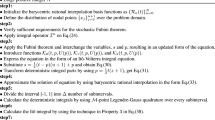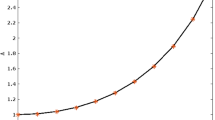Abstract
In contrast to the existing plethora of adaptive numerical methods for differential and integro-differential equations, there seems to be a shortage of adaptive methods for purely integral equations with weakly singular kernels, such as the first kind Abel equation. In order to make up this deficiency, an adaptive procedure based on the product-integration method of Huber is developed in this work. In the procedure, an a posteriori estimate of the dominant expansion term of the local discretisation error at a given grid node is used to determine the size of the next integration step, in a way similar to the adaptive solvers for ordinary differential equations. Computational experiments indicate that in practice the control of the local errors is sufficient for bringing the true global errors down to the level of a prescribed error tolerance. The lower limit of the acceptable values of the error tolerance parameter depends on the interference of machine errors, and the quality of the approximations available for the method coefficients specific for a given kernel function.
Similar content being viewed by others
References
Adolfsson K, Enelund M, Larsson S (2003) Adaptive discretization of an integro-differential equation with a weakly singular convolution kernel. Comput Methods Appl Mech Eng 192: 5285–5304
Baker CTH (1977) The numerical treatment of integral equations. Clarendon Press, Oxford
Bieniasz LK (1992) ELSIM-A user-friendly PC program for electrochemical kinetic simulations. Version 1.0-solution of integral equations for linear scan and cyclic voltammetry. Comput Chem 16: 11–14
Bieniasz LK (1993) An efficient numerical method of solving integral equations for cyclic voltammetry. J Electroanal Chem 347: 15–30
Britz D (2005) Digital simulation in electrochemistry, 3rd edn. Springer, Berlin
Cameron RF, McKee S (1983) High accuracy product integration methods for the Abel equation, and their application to a problem in scattering theory. Int J Numer Methods Eng 19: 1527–1536
Cameron RF, McKee S (1984) High accuracy convergent product integration methods for the generalized Abel equation. J Integral Equations 7: 103–125
Cameron RF, McKee S (1985) The analysis of product integration methods for Abel’s equation using discrete fractional differentiation. IMA J Numer Anal 5: 339–353
Carey GF (1997) Computational grids generation, adaptation and solution strategies. Taylor & Francis, Washington
Cody WJ (1969) Rational Chebyshev approximations for the error function. Math Comput 23: 631–637
Cody WJ, Paciorek KA, Thacher HC Jr. (1970) Chebyshev approximations for Dawson’s integral. Math Comput 24: 171–178
Gorenflo R, Vessella S (1991) Abel integral equations. Lect Notes Math 1461: 1–215
Gustafsson K (1994) Control-theoretic techniques for stepsize selection in implicit Runge-Kutta methods. ACM Trans Math Softw 20: 496–517
Huber A (1939) Eine Näherungsmethode zur Auflösung Volterrascher Integralgleichungen. Monatsschr Math Phys 47: 240–246
Jiang Y (2007) Adaptive collocation methods for Volterra integral and integro-differential equations. Appl Math Comput 191: 67–78
López-Fernández M, Lubich C, Schädle A (2008) Adaptive, fast, and oblivious convolution in evolution equations with memory. SIAM J Sci Comput 30: 1015–1037
Lovrić M (1996) Simulation of electrochemical problems by numerical integration. Russ J Electrochem 32: 988–995
Lubich C (2004) Convolution quadrature revisited. BIT Numer Math 44: 503–514
McKee S (1982) A review of linear multistep methods and product integration methods and their convergence analysis for first kind Volterra integral equations. In: Baker CTH, Miller GF(eds) Treatment of integral equations by numerical methods. Academic Press, London, pp 153–161
Mirkin MV, Nilov AP (1991) Modification of the Huber method for solving integral equations on a non-uniform grid. Comput Chem 15: 55–58
Nicholson RS, Shain I (1964) Theory of stationary electrode polarography, single scan and cyclic methods applied to reversible, irreversible, and kinetic systems. Anal Chem 36: 706–723
Nicholson RS, Olmstead ML (1972) Numerical solution of integral equations. In: Mattson JS, Mark HB Jr., MacDonald HC Jr. (eds) Computers in chemistry and instrumentation, vol 2, electrochemistry, calculations, simulation, and instrumentation. Marcel Dekker, New York, pp 119–138
Söderlind G (1998) The automatic control of numerical integration CWI Quart 11: 55–74
Weiss R, Anderssen RS (1972) A product integration method for a class of singular first kind Volterra equations. Numer Math 18: 442–456
Weiss R (1972) Product integration for the generalized Abel equation. Math Comput 26: 177–190
Author information
Authors and Affiliations
Corresponding author
Rights and permissions
About this article
Cite this article
Bieniasz, L.K. An adaptive Huber method with local error control, for the numerical solution of the first kind Abel integral equations. Computing 83, 25–39 (2008). https://doi.org/10.1007/s00607-008-0010-y
Received:
Accepted:
Published:
Issue Date:
DOI: https://doi.org/10.1007/s00607-008-0010-y
Keywords
- The first kind Abel integral equations
- Adaptive methods
- A posteriori error estimation
- Product-integration
- Huber method
- Computational electrochemistry




